


The Jurassic period is a part ofEarth’shistory based on the rock records left behind called theGeologic Time Scale.
The Jurassic period is known for the abundance ofdinosaursthat dominated the planet at the time. It is also whenmammalsbegin to thrive and marks the period before they would inherit dominance of the Earth from the dinosaurs.
The Jurassic period is named after theJura Mountainsin the western Alps,where layers of limestone of the period were first identified.
The Jurassic period began roughly 199.6 million to 145.5 million years ago (Mya). It started after a mass extinction event marking the end of the Triassic period, aptly named the “End-Triassic Extinction,” and ended with another, albeit smaller, extinction event.
This extinction event is unclear to geologists and palaeontologists. Still, it has been speculated that massive methane deposits on the seabed were released, altering the Earth’satmosphere, causingglobal warming, and ultimately altering the climate.
These changes in the Earth’s environments caused many species for which the Jurassic period came to be known to die out. The rise of other species, such as mammals, gave way to another period known as the Cretaceous period.
Within the Geologic Time Scale, the Jurassic period lies within a larger measurement of time called an “era,” referred to as theMesozoic. It is the second period of the Mesozoic, preceded by theTriassicand followed by theCretaceousperiod.

|
Era |
Period |
|
Cenozoic (65 Mya - Now) |
Quaternary (2.58 Mya - Now) |
|
Neogene (23- 2.58 Mya) |
|
|
Palaeogene (66 - 23 Mya) |
|
|
Mesozoic (250 - 65 Mya) |
Cretaceous (145 - 66 Mya) |
|
Jurassic (201 - 145 Mya) |
|
|
Triassic (251 - 201 - Mya) |
|
|
Paleozoic (540 - 250 Mya) |
Permian (299 - 251 Mya) |
|
Carboniferous (349 - 299 Mya) |
|
|
Devonian (419 - 359 Mya) |
|
|
Silurian (444 - 419 Mya) |
|
|
Ordovician (485 - 444 Mya) |
|
|
Cambrian (540 - 485 Mya) |
|
Period |
Epoch |
|
Jurassic Period |
Late (163.5 - 145.0 Mya) |
|
Middle (174.1 - 163.5 Mya) |
|
|
Early (201.3 - 174.1 Mya) |
Check out our other Teaching Wiki aboutDinosaur Periods Timeline!
At the beginning of the Jurassic, all of the world's continents as we know them now were all part of one "supercontinent" calledPangea. During the Early Jurassic period, it began to break apart and drift into separate supercontinents calledLaurasiain the north and theGondwanain the south.
The break betweenNorth AmericaandAfricawas the first to happen in the early Jurassic. ThenMadagascarandAntarcticabegan to rift away from Africa, which opened theIndian Oceanand started the fragmentation of Gondwana. At the beginning of the Jurassic, North andSouth Americaremained connected. However, by the beginning of the Late Jurassic, they had drifted apart and formed theCaribbean Sea.
Before Pangea began breaking apart and forming different oceans along with continents, it was surrounded by one "superocean" called Panthalassa. Then theTethys Oceanbegan developing between Gondwana and Asia. While the North Atlantic Ocean remained relatively narrow, the South Atlantic would not open until the following Cretaceous period.
At the end of the Triassic, central and westernEuropewere consumed by shallow seas and formed an archipelago of islands rather than the land we know today. During the Jurassic, both theNorthand South Polesweren't the ice caps they are today but rather covered by oceans.
If you travel back in time to the Jurassic period, one of the first things you would notice is how much warmer it is than the present. 41 °F - 50 °F to be approximate. This is especially true of the beginning of the Jurassic, which was marked by a thermal spike due to the volcanic eruptions of the Triassic–Jurassic extinction event. The atmospheric carbon dioxide levels were also likely four times higher.
Nearer to the poles, it is thought that forests grew there due to the warm summers and cold (sometimes snowy winters) they experienced. Whereas tropical rainforests and tundras are likely to have been rare or absent. Scientists also think it was unlikely there were ice sheets, considering the higher temperatures. Although there may have been glaciers in some mountains.
The interiors of the smaller continents post-Pangea breakup was also less severe than during the Triassic, as the newly formed oceans had mitigating effects. This is likely to have resulted in morehumid, subtropical biomes.
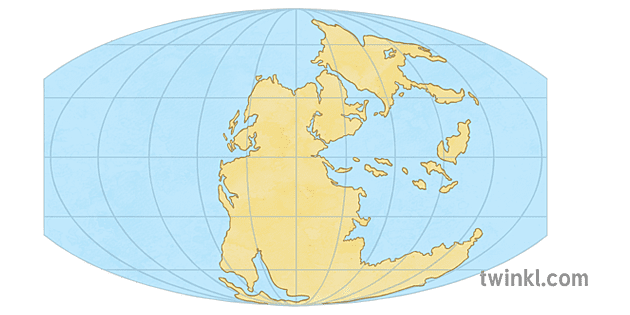
Dinosaurs were undoubtedly the headliners of the Jurassic period. They had exploded during the Early Jurassic in the aftermath of the end-Triassic extinction. The extinction of other reptile groups allowed the dinosaurs to diversify and occupy niches that now opened up. This significant increase in diversity and abundance ensured they were the dominant terrestrialvertebratesof the Jurassic period.
Dinosaurs are generally classified into either of two categories:OrnithischiaorSaurischia. Both classifications denote how their pelvis is arranged.
Theropods are a group of dinosaurs characterized by walking on two legs, hollow bones, three toes, and claws on each limb. Although they were initiallycarnivorous, some Theropod groups evolved to become herbivores, omnivores, piscivores (fish-eaters), and insectivores (insect-eaters). This is an excellent example of how dinosaurs diversified during the Jurassic. Some of the most famous theropods were theTyrannosaurus RexandVelociraptors(made famous by a certain movie franchise); however, both of these species lived during the Cretaceous period.
Four distinct groups of Theropods during the Jurassic period included the Ceratosaurs, Megalosaurs, Allosaurs, and Coelurosaurs. The Allosaurs were the largest, reaching lengths of 35 ft. Palaeontologists believe that Theropods' superior speed and two-legged gait allowed them to take down larger, slower prey. They were also opportunistic hunters who worked in packs.
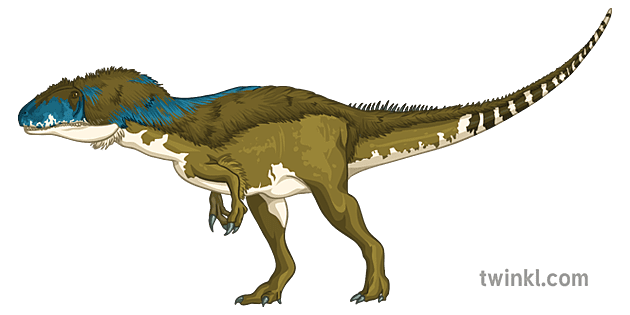
It is also thought that most Theropods evolved fromArchosaursin the late Triassic period and continued to evolve until the end of the Cretaceous period when dinosaurs finally died out.
Sauropods first appeared during the Early to Middle Jurassic period. They would go on to evolve into the well-known lines of the Brachiosaurus, Cetiosaurids, Diplodocus, Camarasaurids, Titanosaurids, Apatosaurus, and Brontosaurus over the course of 100 million years.
Sauropods have long tails, four thick legs, small heads relative to the rest of their body, and long necks to access out-of-reach vegetation. They are notable for being the largest creatures to ever walk the Earth, and their fossils have been found on every continent, including Antarctica. However, the largest Sauropod of the Jurassic period was the Supersaurus, reaching lengths between 108 - 115 ft and weighing between 35 - 44 tons.
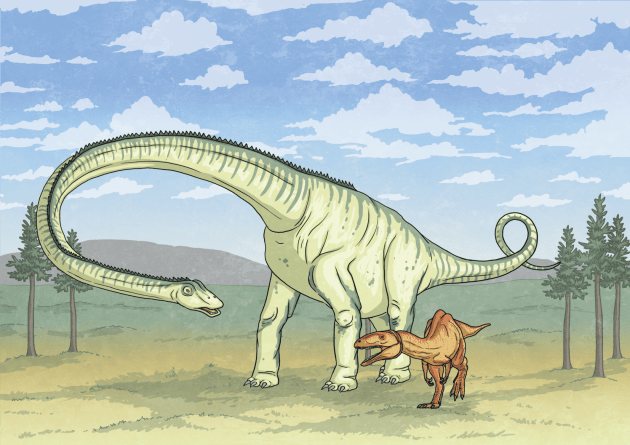
The Ornithopods are recognized as having a beak, walking on either two or four legs, and eating only plants. They also had hips set out more like birds than other dinosaurs, with pelvises where the long pubis pointed backwards rather than forwards. Ornithopods sprang up in the late Triassic and lived throughout the Jurassic extending through the Cretaceous period.
Examples of Ornithopods that graced the Earth during the Jurassic period include the Agilisaurus, Iguanodon, Dryosaurus, and Phyllodon. Iguanodons, in particular, are famous because they are one of the first-ever dinosaurs to be scientifically identified all the way back in 1825 England.
Iguanodons were bulky herbivores that could switch between walking on two or four legs. Some are thought to have reached up to 39 ft long and weighed between 3 - 4 tons. This, coupled with their bulky three-toed legs, means they probably only reached speeds of around 14 mph. They had conical spikes for thumbs used for either foraging or defense. Their skulls were tall but narrow with toothless beaks containing teeth like an iguana's - hence the name.
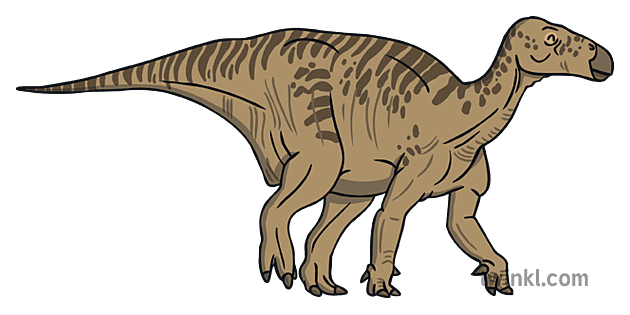
Check out our Teaching Wiki all aboutDuck-Billed Dinosaurs!
Recognized by the line of plates which ran down its back in two columns, the Stegosaurus is one of the most iconic dinosaurs to have been discovered. They lived during the late Jurassic period in what is known now as Western North America and Europe. They were large quadrupeds (measuring around 30 ft long and standing around 39 ft tall) with rounded backs and short front legs, allowing for a low head position. At the same time, its tail was held up high in the air.
Because of this head positioning, it is thought the Stegosaurus was a low-grazer. The tails position also meant it could use the large spikes which protruded from it in battle against another Stegosaurus or predators. It is believed that the large armored plates which ran up and down the dinosaurs back played a part in defense, attracting a mate, as well as regulating its body temperature.
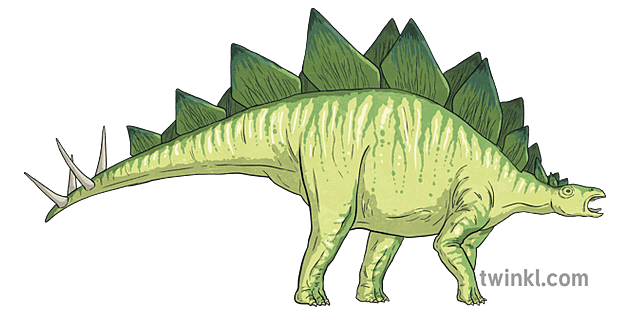
Check out our other Teaching Wiki all about Different Types of Dinosaurs!
Pterosaurs, meaning "wing lizard," were a group of flying reptiles that existed during most of the Mesozoic. They first emerged in the Late Triassic and lived throughout the Jurassic and to the end of the Cretaceous. Their wings were formed by a membrane of skin, muscle, and other tissues stretching from the ankles to an elongated fourth digit.
Pterosaurs spanned a wide range of sizes, from the very small to the largest known flying creatures. With lifestyles also ranging from fish-eaters, carnivores, insectivores, fruit eaters, and even eating other pterosaurs.
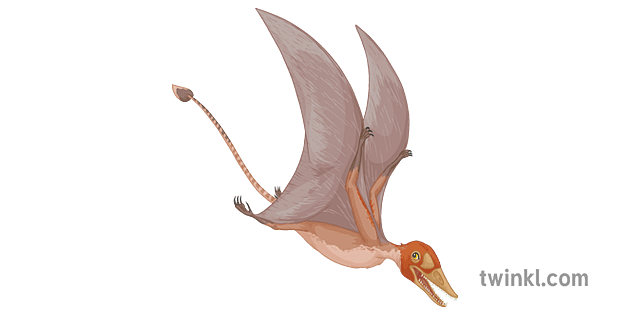
Pterosaurs' bodies and parts of their wings were covered in hair-like filaments known aspycnofibers. These grew in different ways, from simple filaments to ornate feathers. Their coats would have appeared smooth or fluffy but did not resemble bird feathers. They had beaks, but some groups lacked teeth. Some groups also developed elaborate head crests, such as modern bird species.
They reproduced by laying eggs (fossils of which have been discovered) and were warm-blooded. They also breathed using air sacs, which hollowed out their bones, making them highly adept flyers. However, on the ground, they would have had awkward postures. But strong joints and claws suggest they would have been efficient climbers and could have lived in trees.
Pterosaurs are often referred to in popular culture as either dinosaurs or pterodactyls. However, both are incorrect. Dinosaurs are a different branch of reptiles than pterosaurs, and pterodactyls are a specific group.

Did you know?The largest pterosaur of the Jurassic period was theDearc, discovered in Scotland, with wingspans around 10 ft long!
Ichthyosaurs were large marine reptiles that lived through much of the Mesozoic era and were especially numerous in the Late Triassic and Early Jurassic periods. They were later replaced by Plesiosaurs as the top aquatic predators. During the Early Triassic, ichthyosaurs evolved from a group of land reptiles that returned to the sea.
There were many species of Ichthyosaur across the ages, and they varied from 3 - 66 ft in length. Ichthyosaurs resembled modern fish and dolphins, with limbs that had transformed into flippers, pointed heads, and slender jaws adorned with conical teeth used to catch smaller prey. Ichthyosaurs also breathed air, were warm-blooded, bore live young, and may have had a layer of fat for insulation, like dolphins and whales.
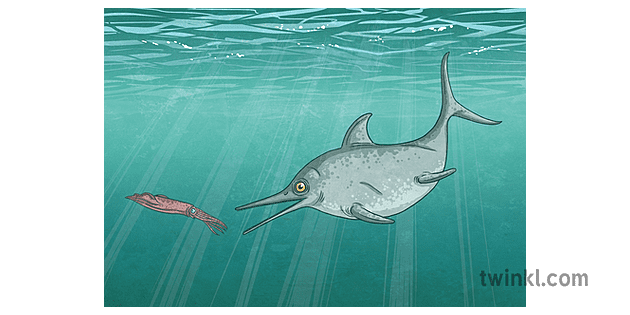
Plesiosaurs were another type of marine reptile that first appeared in the Late Triassic period about 203 million years ago. They became especially prevalent during the Jurassic Period, thriving until the end of the Cretaceous Period, about 66 million years ago. They had a worldwide oceanic distribution, and some species at least partly inhabited freshwater environments.
Plesiosaurs had broad flat bodies and short tails. Their limbs had evolved into four long flippers powered by solid muscles that made a flying movement through the water. Plesiosaurs breathed air, bore live young, and some indications that they were warm-blooded, much like Ichthyosaurs did.

Some species had long necks and small heads that were relatively slow and caught small sea animals. Other species reached a length of up to 55 ft! They had short necks and large heads, making them fast hunters of large prey, taking the Ichthyosaur's spot as apex predators.
Dinosaurs may have been the dominant terrestrial animals, but another group was waiting in the wings for their turn on the throne - the mammals. Early mammals, such asCynodontsthat lived in the Triassic also followed suit with the dinosaurs by diversifying massively in the Jurassic.
Early mammals were mainly very small, shrew-like herbivores or insectivores. They carved out their own niches, such as beingnocturnalhunters ensuring they were not in direct competition with the larger reptiles.
One of the branches of mammals that developed in the Jurassic was the firstTherianmammal. Therians were the ancestors of all today’s mammals (except for the egg-layingmonotremes). They gave birth to live young rather than laying eggs.
Although evidence suggests, most early mammals lived on the ground and in burrows. The forelimbs of theJuramaia(a shrew-like mammal)propose they may have been adapted to climbing, possibly spending at least some of their life in the trees. Others were adapted to aquatic life, similarly to the platypus and otters. While others had a membrane of skin called a “patagium” from their limbs, similar to flying squirrels, allowing them to glide through the air. TheFruitafossorwas a specialist on colonial insects, like the modern aardvarks or anteaters.

Did you know?Monotremes are a group of mammals that diverged before the Therians (which most modern mammals are descended from), who lay eggs. Surprisingly, a few examples have survived until today, including the duck-billed platypus and four types of echidnas.
Insects are known to have first appeared at least in the Devonian Period, over 200 million years before the Jurassic Period. However, their continuous evolution and diversification meant that several new groups emerged during the Jurassic Period. Of all these new insect groups that sprang up, one particular order survives to this day -Lepidoptera– or better known as butterflies and moths!
It wasn’t just animals that flourished during the Jurassic period, as plants also evolved and diversified into a plethora of new species adapted to their new world. Plants also had the advantage of not having gone through a mass extinction as their animal counterparts did in the Triassic-Jurassic crossover.
Most tree species during this time were gymnosperms, a type of tree whose seeds are “naked” - meaning they are not enclosed, such as conifers, cycads, Ginkgoales, and yews.
These trees are named after the seed-bearing cones they produce. They are perennial, meaning they live longer than two years and have needle-like leaves, such as a traditional Christmas tree. A noticeable component of the Jurassic flora was conifers. During the Late Triassic and Jurassic, conifers underwent a significant period of diversification, with most modern conifer groups appearing in the fossil record by the end of the Jurassic.
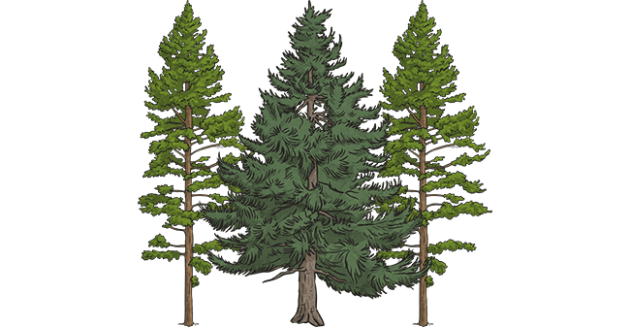
Ferns are an extremely old type of vascular plant, first appearing in theDevonian period around 360 Mya. They reproduce using spores rather than seeds or flowers and appear curled up before unfurling in the spring. Many families of ferns lived throughout the Jurassic period, and they were quite successful, as attested by their widespread range. Although ferns are commonly found in the modern world, 80% of them are thought to descend fromPolypodiales. No fossil records of them from the Jurassic are thought to have diversified in the Cretaceous .

Ginkgoales is another gymnosperm with only one surviving member, theGinkgo biloba, or “ginkgo tree,” native to modern-dayChina. During the Jurassic, however, they were more diverse and widespread throughout the northern hemisphere . Ginkgos have small, flat, fan-like leaves and are unique because they reproduce by pollen rather than seeds or flowers.
Cycads are seed-bearing plants with a short, woody trunk supporting a head of large, stiff leaves resembling palms or ferns, which they are often mistaken for. Typically, they grow very slowly and live a long time. Cycads are thought to have reached the pinnacle of their diversity during the Jurassic and following the Cretaceous period. Although probably would have been mostly confined to tropical and subtropical regions. Modern cycads are pollinated by beetles, and this relationship is thought to have formed by the Early Jurassic.
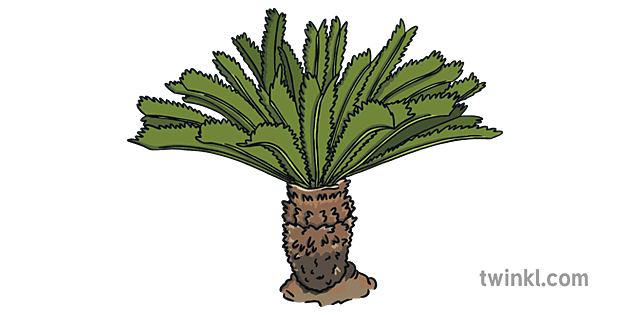
Use our Geological Timescale for the Time of the Dinosaurs to discuss and review the periods within the Mesozoic era, including the Jurassic period. This scale is perfect for general interest or within a specific unit of study.
Your budding palaeontologists will love learning more about dinosaurs and building math, language, and science skills with our All About Dinosaurs Activity Booklet. Use this activity booklet to add to a lesson or unit on dinosaurs to extend children's knowledge and understanding. Each page includes dinosaur-themed math, science, or ELA activity for children to complete as a group or independently. This activity booklet also makes an excellent addition to your road trips to keep children engaged and learning!
Set up an engaging and inviting dinosaur-themed dramatic play area for students to explore in your classroom with our Early Childhood Fossil Hunter Dramatic Play Pack. Students will love pretending to be fossil hunters using the hands-on resources included in this dinosaur-themed pack. This Fossil Hunter Dramatic Play Pack is a great resource to be paired with toy dinosaurs, museum props, and dress-up clothes.